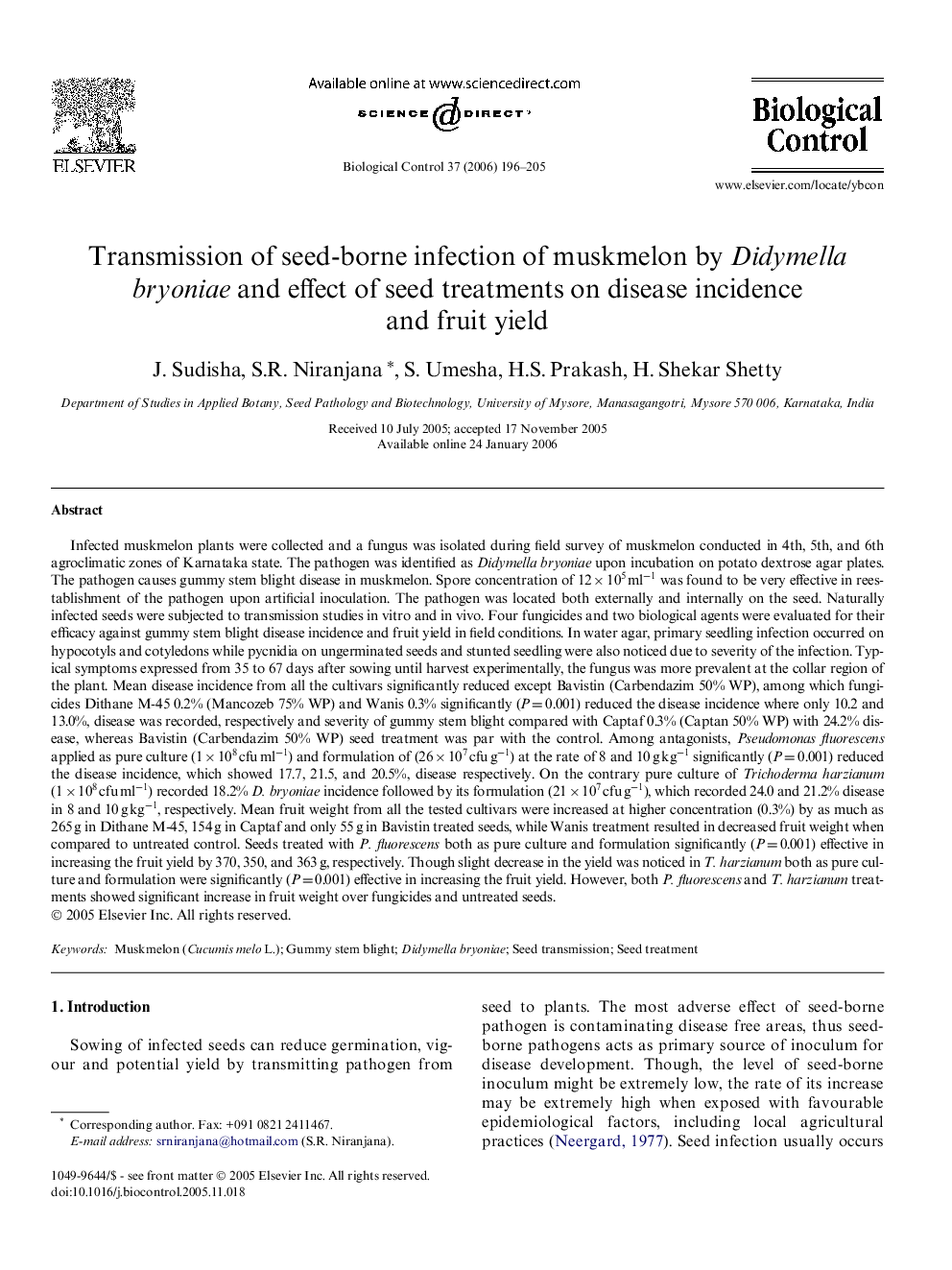| کد مقاله | کد نشریه | سال انتشار | مقاله انگلیسی | نسخه تمام متن |
|---|---|---|---|---|
| 4505456 | 1321146 | 2006 | 10 صفحه PDF | دانلود رایگان |

Infected muskmelon plants were collected and a fungus was isolated during field survey of muskmelon conducted in 4th, 5th, and 6th agroclimatic zones of Karnataka state. The pathogen was identified as Didymella bryoniae upon incubation on potato dextrose agar plates. The pathogen causes gummy stem blight disease in muskmelon. Spore concentration of 12 × 105 ml−1 was found to be very effective in reestablishment of the pathogen upon artificial inoculation. The pathogen was located both externally and internally on the seed. Naturally infected seeds were subjected to transmission studies in vitro and in vivo. Four fungicides and two biological agents were evaluated for their efficacy against gummy stem blight disease incidence and fruit yield in field conditions. In water agar, primary seedling infection occurred on hypocotyls and cotyledons while pycnidia on ungerminated seeds and stunted seedling were also noticed due to severity of the infection. Typical symptoms expressed from 35 to 67 days after sowing until harvest experimentally, the fungus was more prevalent at the collar region of the plant. Mean disease incidence from all the cultivars significantly reduced except Bavistin (Carbendazim 50% WP), among which fungicides Dithane M-45 0.2% (Mancozeb 75% WP) and Wanis 0.3% significantly (P = 0.001) reduced the disease incidence where only 10.2 and 13.0%, disease was recorded, respectively and severity of gummy stem blight compared with Captaf 0.3% (Captan 50% WP) with 24.2% disease, whereas Bavistin (Carbendazim 50% WP) seed treatment was par with the control. Among antagonists, Pseudomonas fluorescens applied as pure culture (1 × 108 cfu ml−1) and formulation of (26 × 107 cfu g−1) at the rate of 8 and 10 g kg−1 significantly (P = 0.001) reduced the disease incidence, which showed 17.7, 21.5, and 20.5%, disease respectively. On the contrary pure culture of Trichoderma harzianum (1 × 108 cfu ml−1) recorded 18.2% D. bryoniae incidence followed by its formulation (21 × 107 cfu g−1), which recorded 24.0 and 21.2% disease in 8 and 10 g kg−1, respectively. Mean fruit weight from all the tested cultivars were increased at higher concentration (0.3%) by as much as 265 g in Dithane M-45, 154 g in Captaf and only 55 g in Bavistin treated seeds, while Wanis treatment resulted in decreased fruit weight when compared to untreated control. Seeds treated with P. fluorescens both as pure culture and formulation significantly (P = 0.001) effective in increasing the fruit yield by 370, 350, and 363 g, respectively. Though slight decrease in the yield was noticed in T. harzianum both as pure culture and formulation were significantly (P = 0.001) effective in increasing the fruit yield. However, both P. fluorescens and T. harzianum treatments showed significant increase in fruit weight over fungicides and untreated seeds.
Journal: Biological Control - Volume 37, Issue 2, May 2006, Pages 196–205